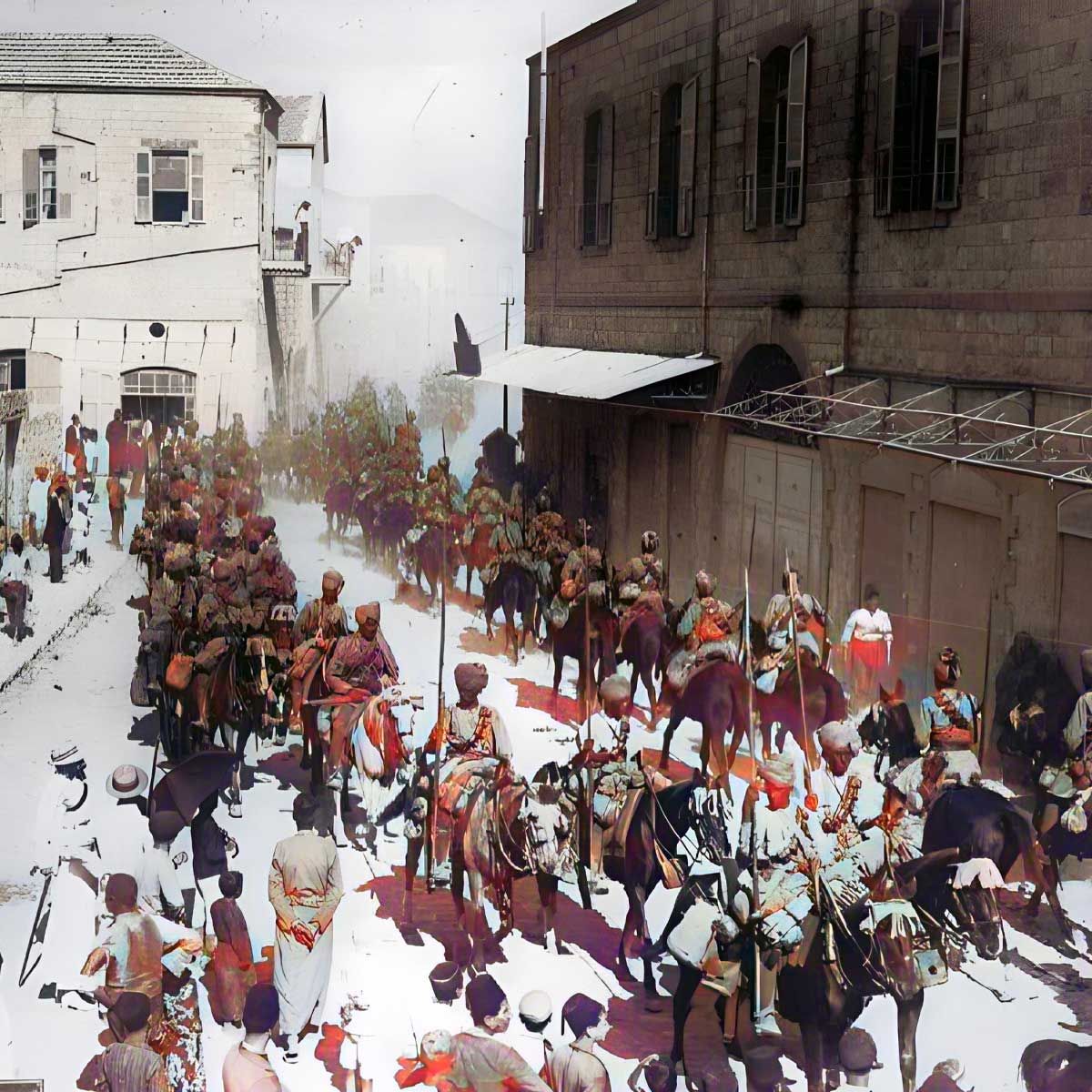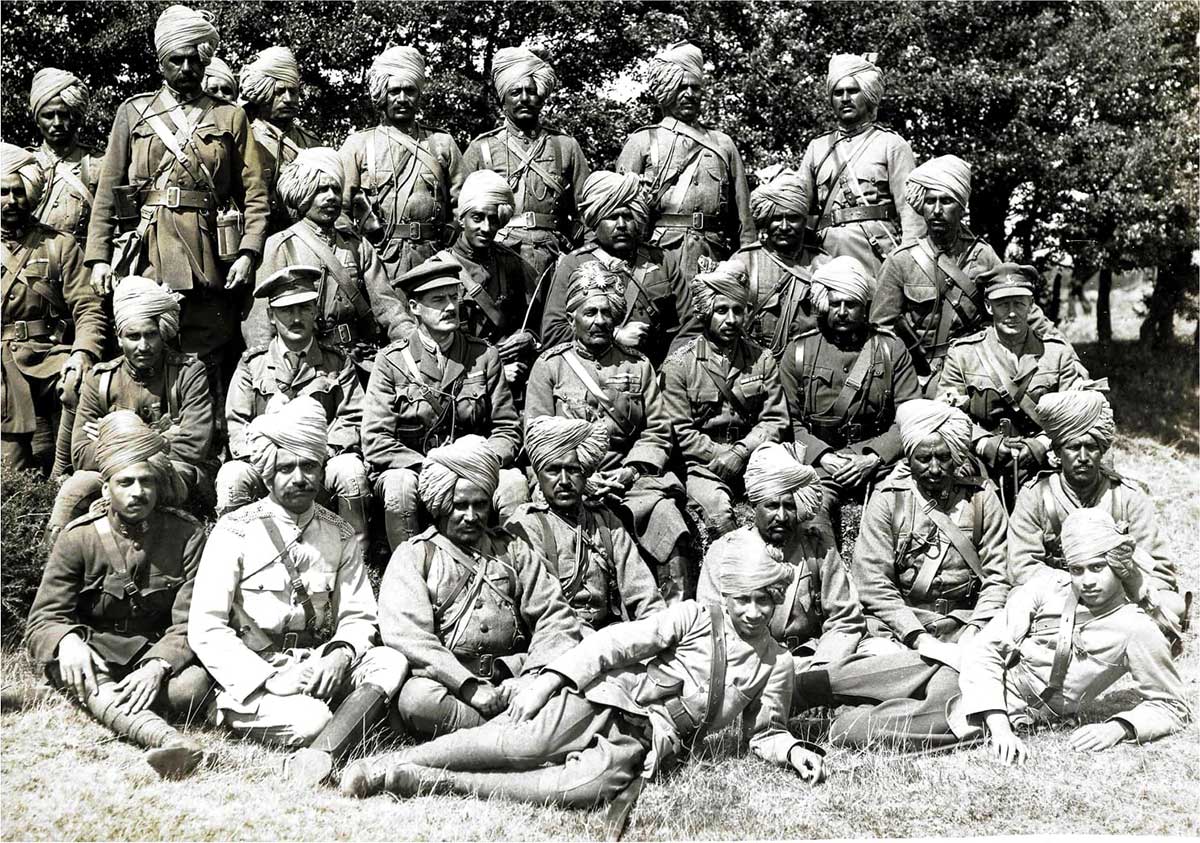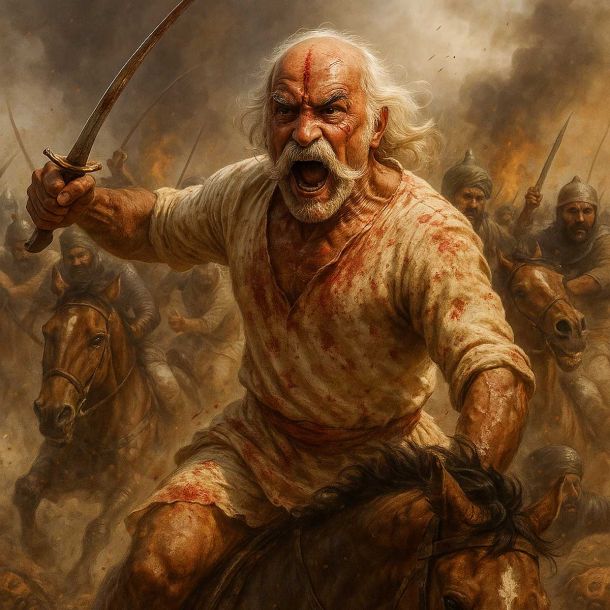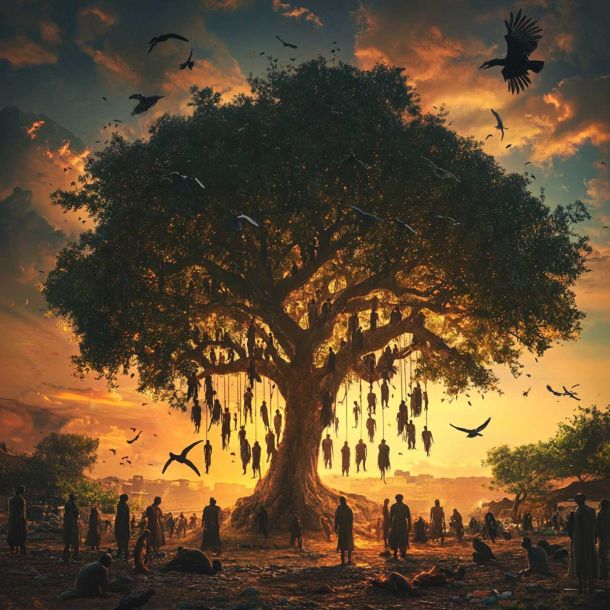Sanatan Articles
Satyaagrah
Written on
Satyaagrah
Written on
Satyaagrah
Written on
Satyaagrah
Written on
Satyaagrah
Written on
JOIN SATYAAGRAH SOCIAL MEDIA
"History's unsung heroes sing the loudest": Lost in history's pages, Battle of Haifa reveals India's unsung heroes from the Jodhpur Lancers, on Sept 23, 1918, their courage freed Haifa from Ottoman chains, deepening an enduring bond between India & Israel

For the longest time, the heroics of the Indian soldiers during the Battle of Haifa were shadowed, receiving scant attention until Jodha's illuminating research. An annual homage unearths this buried piece of history, shining a light on the bravery displayed on foreign soil.
|
Every September 23rd, a solemn assembly is observed at the Haifa War Cemetery. Diplomats from the Indian Embassy in Israel unite with Israeli government officials. This congregation from both nations honors the memory of the Indian soldiers - those who gave their lives and those who bore wounds during the fierce battle. Their valor remains imprinted on the soil of the northern port city of Haifa.
In continuation of a tradition that has been honored for more than a decade, the Indian Embassy in Israel released a statement this year. The announcement highlighted that both the Indian Ambassador and the Mayor of Haifa have "paid tributes to the valiant Indian soldiers who liberated Haifa on Sep 23, 1918". This year was particularly significant as it marked the 105th anniversary of the Battle of Haifa.
The tales of Indian soldiers' valor at the Battle of Haifa, serving under the banner of the British Empire, remained buried for over nine decades. These courageous men, who fought fearlessly on foreign shores, found mere mentions in obscure pages of history books and archives. Brig. M S Jodha (Veteran), an ex-officer of the Indian Army and the acclaimed author of ‘The Story of the Jodhpur Lancers’, notes the glaring omission: “Haifa Day was left uncelebrated until 2010 simply because of the collective amnesia about this historic event,” Jodha remarks.
Yet, for Jodha, this battle was never a forgotten tale. Childhood evenings for him were colored with stories of this battle, narrated from a deeply personal perspective. His grandfather, Lt. Col. Aman Singh, OBI, IOM, was at the heart of this saga. It was under Lt. Col. Aman Singh's leadership that the Jodhpur Lancers made a momentous cavalry charge at Haifa on that fateful day of September 23, 1918. This fearless charge culminated in a resounding victory for the British Empire.
It took Jodha's relentless pursuit, spanning two decades of dedicated research, to bring to light the pivotal role played by these Indian soldiers. His efforts bore fruit, ensuring that their sacrifices were recognized and lauded by both the Indian and Israeli governments. The shadows of history finally gave way to the spotlight of honor and remembrance.
|
The Domino Effect: The Broader Impacts of the Battle of Haifa
The First World War was marked by a myriad of battles, each with its own significance. Yet, amongst these numerous encounters, the Battle of Haifa occupies a unique place. It was an integral component of the Sinai and Palestine campaign, where forces of the British Empire, the French Third Republic, and the Kingdom of Italy teamed up with the Arab Revolt. Together, they squared off against a formidable coalition of the Ottoman Empire, the Austro-Hungarian Empire, and the German Empire.
While the Battle of Haifa might not ring as loud in the annals of history as some other battles of the First World War, its ripple effects on global geopolitics cannot be understated. The outcome of this battle was not merely a win or loss in a single campaign. Instead, it played a pivotal role in reshaping the map of the modern Middle East.
The downfall of the mighty Ottoman Empire began with its partition after this war. This seismic shift in power dynamics paved the way for the birth of the Republic of Turkey in 1923. The reverberations of this event were felt over subsequent decades, leading to the formation of several new nations. The Kingdom of Iraq emerged in 1932, followed by the Lebanese Republic in 1943. The Hashemite Kingdom of Jordan and the Syrian Arab Republic saw their genesis in 1946. The changes culminated with the proclamation of the State of Israel in 1948.
Thus, the Battle of Haifa was not just a clash between empires, but a crucible where the destiny of multiple nations was forged.
|
India's Unsung Heroes: The Jodhpur Lancers in the Battle of Haifa
The First World War witnessed nations from all corners of the globe converging on battlefields, united by alliances and driven by causes. Amidst this vast ensemble of military might, the involvement of the Jodhpur Lancers stands out as a testament to India's integral role in the war efforts.
As Brig. M S Jodha’s exhaustive research reveals, the onset of the war in July 1914 swiftly brought its echo to the princely state of Jodhpur by early August. Recognizing the scale and significance of the impending conflict, Sir Pratap Singh - an accomplished British Indian Army officer, the Maharaja of Idar, and the Regent of Jodhpur - promptly pledged the might and resources of his state to the British war endeavor.
However, Jodhpur was not alone. The British Indian government, capitalizing on this momentum, appealed to other princely states for military assistance. As a result, troops from various princely states, including Jodhpur, were deployed overseas. These brave soldiers, though representing their respective states, would don the uniform of the British Indian Army, symbolizing their commitment to the collective cause.
Jodhpur's commitment was both prompt and profound. At their own expense, they provided not just troops but also essential logistics such as horses, tents, clothing, and other equipment. For the Battle of Haifa, the Jodhpur Lancers underwent a strategic reorganization. Both its regiments amalgamated to form a cohesive unit, further strengthened by a squadron from the Alwar Imperial Service Lancers. This formidable unit, totaling over 600 men and almost 700 animals, was poised to play a decisive role in the forthcoming battle.
General Edmund Allenby, the British commander of the Egyptian Expeditionary Force, understood the strategic importance of Haifa. The port city was not just a harbor but a pivotal railhead. Seizing it would ensure a steady supply chain, a crucial factor in warfare. Jodha's writings underscore this urgency, illustrating how Allenby's objective to secure Haifa aligned with the valor and vigor of the Jodhpur Lancers.
|
In an era where the heroics of many are often overshadowed by the grandeur of a few, the tale of the Jodhpur Lancers serves as a poignant reminder of India's significant and selfless contribution to global events.
On September 22, word spread like wildfire: Haifa, a city of strategic importance, remained firmly under the control of the Ottoman forces. The British Empire, recognizing the pressing need to liberate Haifa, tasked the 5th Cavalry Division with the daunting mission on September 23. This division, a composite of the 13th, 14th, and 15th Cavalry Brigades, would be the spearhead of the assault. The Jodhpur Lancers, flanked by the Mysore and Hyderabad Lancers, were integral components of the 15th Brigade.
However, there was an unforeseen challenge. The Hyderabad Lancers were lagging by 50-60 km, and thus, it was up to the Jodhpur Lancers, with support from the Mysore Lancers, to spearhead the charge into Haifa, a city fortified by the formidable defenses of the Ottoman artillery positioned by the Kishon River and the imposing Mount Carmel.
The detailed accounts that Jodha has curated over the years paint a vivid picture of the actual battle, particularly highlighting the bravery and tenacity of the Jodhpur Lancers. It wasn't just a regular charge; this was an uphill battle, both literally and figuratively. The Ottomans, holding the high ground, were armed with the latest weaponry: modern rifles, machine guns, and field artillery. In contrast, the Jodhpur Lancers, true to their name, were armed primarily with lances. These 12-foot-long bamboo weapons, tipped with deadly blades, were not just tools of war but symbols of their indomitable spirit. When deployed in a charge, these lances became extensions of the riders themselves, capable of neutralizing enemies from a distance, thanks to the momentum of the charging horse.
Despite the stark disparity in weaponry and the challenging terrain, the Jodhpur Lancers, with their traditional weapons and sheer courage, managed to break through the formidable Ottoman defenses, exemplifying the age-old adage that it's not just the weapon, but the warrior wielding it, that makes the difference.
|
In this climactic battle for Haifa, the Jodhpur Lancers emerged not just as victors, but as embodiments of bravery and resilience, rewriting the chapters of military strategy with their valor.
When the Jodhpur Lancers entered the battlefield that fateful day, they were led by Major Dalpat Singh Shekhawat, a seasoned officer. However, war has its own cruel ways of altering plans. In a tragic turn of events, just as the Port of Haifa was secured, Major Dalpat Singh fell in the line of duty. The reins of leadership now fell into the capable hands of Lt Col Aman Singh, the next in command. The weight of the responsibility was immense, but so was the spirit of Lt Col Aman Singh.
Lt Col Aman Singh, as illustrated by the photo credits of Brig M S Jodha, is a stalwart figure, leading one of the most commendable cavalry charges in military history. He spearheaded the battle in an era when warfare was undergoing transformation, and tactics had to be reconsidered due to the introduction of the machine gun. The rapid-fire capability of these guns, with a formidable range of 1,200-1,500 yards, was a game-changer in trench warfare.
Undeterred by these lethal weapons, the Jodhpur Lancers, under the fearless leadership of Lt Col Aman Singh, initiated their daring assault at precisely 2 pm. The speed and ferocity of their charge caught the Ottoman Turks off guard. Even with the odds stacked against them, the Lancers, with their sheer audacity, managed to decimate the enemy ranks. They accounted for the death of 80 Ottoman soldiers and took an astonishing 1,350 prisoners, capturing a cache of arms and ammunition in the process.
Brig M S Jodha, in his meticulous accounts, highlighted the surprisingly minimal casualties sustained by the Brigade, given the intense nature of the confrontation. The casualty count stood at seven officers dead, 34 wounded, and a heartbreaking loss of 60 horses, with another 83 injured. From the Jodhpur Lancers, six brave souls lost their lives, and 21 soldiers were injured. The loss of Major Dalpat Singh was deeply felt; he succumbed to his wounds and left behind a legacy of valor and sacrifice.
This chapter of history, while reflecting the horrors of war, also showcases the undying spirit of the soldiers, who, under the astute leadership of Lt Col Aman Singh, managed to turn the tide in the Battle of Haifa. Their bravery and dedication serve as a beacon of inspiration for future generations.
|
Rekindling a Forgotten Valor: The Legacy Lives On
The sands of time have a curious way of erasing the imprints of history. Even the most valiant of victories can get buried under the layers of newer events and shifting priorities. Such was the case with Haifa Day. As Brig M S Jodha notes, the significant role played by Indian soldiers during this pivotal battle went unnoticed for years by both the Indian and Israeli governments. Such crucial pieces of history tend to be forgotten amidst the evolving political and social landscapes.
The aftermath of India’s Independence in 1947 brought its own set of challenges and restructuring. The storied regiments of the princely states, which had once reverberated with tales of unparalleled bravery, faced mergers or dissolutions. The Jodhpur Lancers, the Hyderabad Lancers, and the Mysore Lancers, once the pride of their respective states, were integrated into other regiments or faded into obscurity. Yet, a glimmer of hope remained. In a bid to honor the past and to preserve a touch of regality and tradition, Prime Minister Nehru endorsed the formation of a new cavalry regiment in 1953. The 61st Cavalry regiment, born out of the fusion of Jodhpur, Gwalior, Mysore, and Hyderabad, emerged as a reminder of India's rich martial heritage.
The torchbearers of the legacy, the 61st Cavalry, have since taken it upon themselves to celebrate Haifa Day. The battle honour 'Haifa', a tribute to the audacious charge of the Jodhpur Lancers, proudly finds a place in their annals. Yet, for years, this celebration was an insular affair, confined to the precincts of the regiment. On this day, the regiment would conduct a "badakhana", a ceremonial feast, where officers would assemble to reminisce about the valour of their predecessors.
Brig M S Jodha’s efforts have been instrumental in shining a light on this forgotten chapter, ensuring that the sacrifices made by the Jodhpur Lancers and their contribution to the Battle of Haifa are etched in the collective memory of the nation. As the 61st Cavalry continues to uphold this tradition, it is a stark reminder that while heroes may fade, their legacies endure.
A Testament to Gallantry: The Monuments of Memory
In the annals of history, memorials stand as silent yet powerful testaments to events of monumental significance. The Teen Murti Chowk in New Delhi is one such edifice, bearing witness to the valor of the soldiers of Hyderabad, Mysore, and Jodhpur who displayed unparalleled bravery during the Battle of Haifa. Erected as a symbol of gratitude and respect by the three maharajas of the said princely states, the statues, crowned by three stone figures, have silently observed the passing of time and the rapid evolution of the nation.
Yet, as Brig. M S Jodha observes, the statues gradually turned into passive onlookers in the bustling capital, their historical import understood by only a few. As generations passed, the significance of Teen Murti began to wane, hidden beneath the growing cloak of urban development and the rapid pace of contemporary life. Though the monument remained a notable landmark in the capital, the stories it held and the brave souls it commemorated receded into the shadows.
But thousands of miles away, in the port city of Haifa, another reminder of this historical episode stands firm—the Haifa War Cemetery. Maintained meticulously by the Commonwealth War Graves Commission, it is the final resting place for soldiers who laid down their lives in both World Wars. A poignant note by the Commission mentions the capture of Haifa by the Mysore and Jodhpur Lancers, a reflection of the valour displayed by Indian soldiers on foreign lands.
While the world moved on, the story of the Battle of Haifa seemed destined to remain a forgotten chapter. However, thanks to Brig. M S Jodha's relentless pursuit of truth and passion for history, the tales of heroism have been resurrected. His research acts as a bridge, connecting the past to the present and ensuring that the sacrifices made by Indian soldiers are neither overlooked nor forgotten.
|
Today, as the Teen Murti statues stand tall in the heart of Delhi, they serve as more than just an architectural marvel. They are an embodiment of a legacy, a tribute to the undying spirit of warriors, and a timeless reminder that heroism, no matter how long buried, will always find its way to the light.
History is a tapestry of interwoven narratives that come alive through collective memory, tales of valor, and the preservation of legacies. It is a testament to the tenacity of Brig. M S Jodha's research and passion for history that the story of the Indian soldiers' valor at the Battle of Haifa was brought back to life, bridging the gap between two nations.
The account of the Jodhpur Lancers' extraordinary courage remained a silent whisper, fading with time, until a serendipitous discovery in Haifa in 2005. A simple newspaper clipping from a bygone era, carrying the tales of these brave Indian soldiers, became the conduit for rejuvenating the bond between Israel and India. The Israelis, with their intrinsic value for remembrance, sought answers. India, with its rich tapestry of historical legacy, responded.
The turning point arrived in 2010. Furnished with Jodha's invaluable research, an official commemoration took place in Haifa, acknowledging the significant contributions of Indian soldiers during World War I. This ceremony was not just a mere remembrance but a reaffirmation of shared values and mutual respect between India and Israel. Brig. M S Jodha, representing the lineage of valor, stood as a beacon of this historical connection.
Eight years later, in a moment of profound significance, the Teen Murti Chowk in Delhi was renamed Teen Murti Haifa Chowk. This renaming wasn't just a gesture but a powerful message about the significance of the Battle of Haifa in India's collective memory. Prime Minister Narendra Modi's visit to Israel, where he, alongside Prime Minister Benjamin Netanyahu, paid homage to the fallen heroes, was a testament to the growing camaraderie between the two nations and the acknowledgment of a shared past.
This remarkable journey, from near oblivion to a celebrated chapter of valor, speaks volumes about the importance of history in shaping national identities. It also underscores the pivotal role individuals like Brig. M S Jodha play in ensuring that such tales of bravery and sacrifice are never forgotten. As India and Israel move forward, hand in hand, into a future of shared endeavors and mutual respect, they carry with them the legacy of the Battle of Haifa, a poignant reminder of the past that binds them together.
 |
 Support Us
Support Us
Satyagraha was born from the heart of our land, with an undying aim to unveil the true essence of Bharat. It seeks to illuminate the hidden tales of our valiant freedom fighters and the rich chronicles that haven't yet sung their complete melody in the mainstream.
While platforms like NDTV and 'The Wire' effortlessly garner funds under the banner of safeguarding democracy, we at Satyagraha walk a different path. Our strength and resonance come from you. In this journey to weave a stronger Bharat, every little contribution amplifies our voice. Let's come together, contribute as you can, and champion the true spirit of our nation.
 |  |  |
| ICICI Bank of Satyaagrah | Razorpay Bank of Satyaagrah | PayPal Bank of Satyaagrah - For International Payments |
If all above doesn't work, then try the LINK below:
Please share the article on other platforms
DISCLAIMER: The author is solely responsible for the views expressed in this article. The author carries the responsibility for citing and/or licensing of images utilized within the text. The website also frequently uses non-commercial images for representational purposes only in line with the article. We are not responsible for the authenticity of such images. If some images have a copyright issue, we request the person/entity to contact us at This email address is being protected from spambots. You need JavaScript enabled to view it. and we will take the necessary actions to resolve the issue.
Related Articles
- China attacked India just three years after PM Nehru reduced the defence expenditure by Rs 25 crores: Union Budget 1959
- Operation Polo: When India annexed Hyderabad from the Nizam and Razakars, the suppression of Hindus and the role of Nehru
- In a historical move ahead of Republic Day on January 26th, the Amar Jawan Jyoti flame at the India Gate would be merged with the flame at the National War Memorial on Friday
- ‘Come on, one must not be so narrow-minded’: Supreme Court dismisses plea demanding a total ban on Pakistani artists in India, says... to be a patriot, one must not be hostile to foreigners, also lauds GoI for Cricket World Cup with Pakistan participation
- When in a special referendum in 1975 people of Sikkim chose India over monarchy to become the 22nd State of the Indian Union: Rule of the Chogyal king and his mysterious American Wife Hope Cooke ended
- “This will remain the land of the free so long as it is the home of the brave”: 21-years-old Rifleman Jaswant Singh Rawat martyred in the Indo-China war, held his post for 72 hours and single-handedly killed 300 Chinese soldiers to save Arunachal Pradesh
- "In the new era, thought itself will be transmitted by radio": Indian Army excited for home-grown ‘Tactical LAN Radio’ - a state-of-the-art high bandwidth backhaul wireless radio equipment for the provisioning of reliable and failsafe communication
- "Respect is earned, not given": Italy unveils unique memorial to honour valour & sacrifice of Indian soldiers during World War II for their significant role in liberating Italy, and the enduring gratitude and respect in the hearts of the Italian populace
- Let's see what Sam Manekshaw said when Karan Thapar tried to undermine India’s win in 1971
- Indian Army pacing towards self-reliance under 'Atmanirbhar Bharat Abhiyaan’ campaign: Indigenisation of defence manufacturing is helping to build a new and strong India to keep neighbour aggression in check
- IAF's MiG-21 crashes in Rajasthan's Barmer district, both pilots dead; Rajnath Singh dials Air Force Chief, a court of Inquiry has been ordered to ascertain the cause of the accident
- Assassination of army chief General A.S. Vaidya, who coordinated Operation Blue Star: If a bullet is destined to get me, it will come with my name
- “Only the best of friends and the worst of enemies visit us”: Maj. Kuldeep Singh Chandpuri led the Battle of Longewala in 1971 with 120 soldiers successfully defending an isolated post that was attacked by 4000 troops and 45 tanks of the Pakistan Army
- In Anantnag encounter, valiant hearts DSP Humayun Bhat, Colonel Manpreet Singh, and Major Ashish D met a hero's end, epitomizing the fierce spirit of nationalism, their sacrifice leaves an unyielding nation mourning yet resolute of indomitable spirit
- Srinagar: Top LeT commander, 1 Pakistani terrorist killed in encounter, AK-47s recovered





















